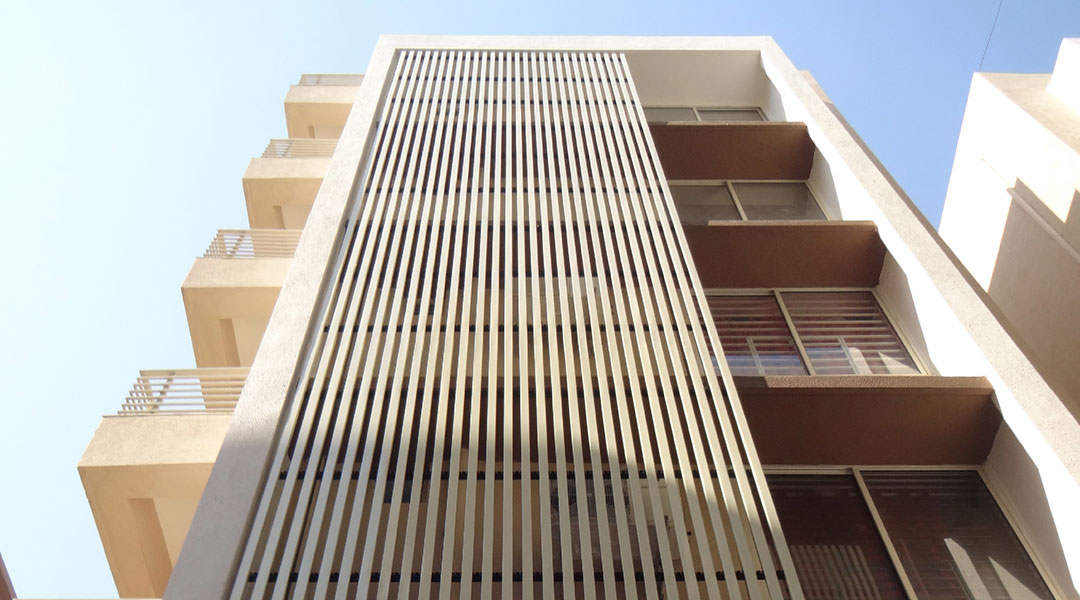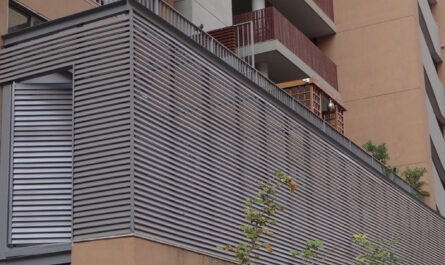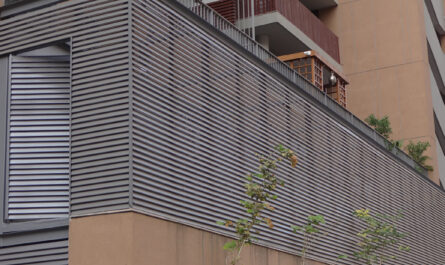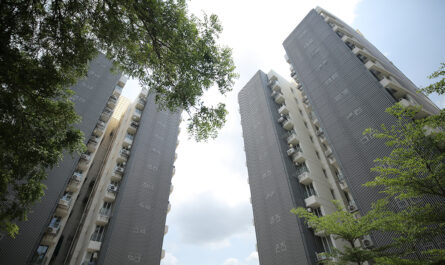Exterior louvres have emerged as a significant architectural element that combines functionality with aesthetic appeal. This analytical study explores how exterior louvres impact natural light and ventilation in both residential and commercial buildings. From energy efficiency to creating comfortable living and working environments, this comprehensive article examines the multifaceted role of exterior louvres in modern architecture and their contribution to sustainable building design.
Section 1: Understanding Exterior Louvres and Their Function
1.1 What Are Exterior Louvres?
Exterior louvres are architectural features consisting of horizontal or vertical slats that are angled to allow light and air to pass through while blocking direct sunlight, rain, and unwanted views. Traditionally used for ventilation and shade, modern exterior louvres have evolved to become sophisticated systems that can significantly impact a building’s performance in terms of natural lighting and air circulation.
1.2 Types of Exterior Louvre Systems
Various types of exterior louvre systems serve different purposes. Fixed louvres maintain a constant angle, providing consistent shading throughout the day. Adjustable louvres can be manually or automatically controlled to adapt to changing environmental conditions. Operable louvres allow for complete closure or opening based on weather conditions or user preferences. Each system offers unique benefits for controlling natural light and ventilation.
1.3 Historical Context and Modern Applications
The use of louvres dates back centuries, with evidence of their application in various cultures to manage harsh climates. In contemporary architecture, exterior louvres have become integral to sustainable building design, adapting traditional principles to modern needs. Today’s applications range from residential windows and doors to large-scale commercial façades that define a building’s character while optimizing its environmental performance.
Section 2: Effect of Exterior Louvres on Natural Light
2.1 Daylighting Optimization
Exterior louvres excel at optimizing daylighting by redirecting sunlight deeper into interior spaces. By blocking direct sun rays while reflecting diffused light inward, louvres reduce glare and create more evenly distributed illumination. This strategic light management can significantly reduce the need for artificial lighting during daylight hours, leading to energy savings and a more pleasant indoor environment.
2.2 Seasonal Light Management
One of the most valuable aspects of exterior louvres is their ability to manage seasonal variations in sunlight. When properly designed and positioned, louvres can be angled to maximize winter sun penetration for passive solar heating while blocking intense summer sun to prevent overheating. This seasonal adaptability contributes to year-round comfort and energy efficiency.
2.3 Glare Reduction and Visual Comfort
Glare can significantly impair visual comfort and productivity, particularly in workspaces with computer screens. Exterior louvres effectively mitigate glare by filtering direct sunlight before it enters the building. Studies have shown that properly designed louvre systems can reduce glare by up to 80% while still maintaining adequate light levels for tasks, creating a more comfortable and productive interior environment.
Section 3: Ventilation Benefits of Exterior Louvres
3.1 Natural Airflow Enhancement
Exterior louvres play a crucial role in facilitating natural ventilation by channeling and directing airflow through buildings. The angled slats create pressure differentials that can enhance cross-ventilation, drawing fresh air in and expelling stale air. This natural air movement can significantly improve indoor air quality by removing pollutants and reducing humidity levels.
3.2 Temperature Regulation Through Ventilation
Strategic placement of exterior louvres can capitalize on prevailing winds and thermal currents to regulate indoor temperatures naturally. In hot climates, louvres can capture cooling breezes while in more temperate regions, they can be adjusted to balance ventilation needs throughout the year. This natural temperature regulation reduces reliance on mechanical cooling systems, contributing to energy efficiency.
3.3 Integration with Mechanical Systems
Modern building design often integrates exterior louvres with mechanical ventilation and cooling systems for optimal performance. Automated louvre systems can work in tandem with HVAC controls, adjusting to outdoor conditions and indoor requirements. This integration allows for a hybrid approach that maximizes natural ventilation when conditions are favorable while seamlessly transitioning to mechanical systems when necessary.
Section 4: Energy Efficiency and Sustainability Impact
4.1 Reduced Cooling Load and Energy Consumption
By effectively managing solar heat gain, exterior louvres can significantly reduce a building’s cooling requirements. Research indicates that properly designed shading systems can decrease cooling energy consumption by 15-30% in commercial buildings. This reduction contributes directly to lower operational costs and smaller environmental footprints.
4.2 Daylight Harvesting and Electrical Lighting Reduction
The strategic use of exterior louvres for daylight harvesting allows buildings to maximize natural light while minimizing artificial lighting needs. Studies have shown that effective daylighting strategies incorporating exterior shading can reduce lighting energy use by up to 60% in perimeter zones. When coupled with automated lighting controls, these savings can extend throughout the building’s operational life.
4.3 Contribution to Green Building Certification
Exterior louvres contribute significantly to achieving green building certifications such as LEED, BREEAM, and Green Star. Their impact on daylighting, natural ventilation, and energy performance addresses multiple credit categories within these rating systems. As sustainability becomes increasingly important in building design and operation, exterior louvres offer a tangible way to improve performance metrics while enhancing occupant comfort.
Section 5: Case Studies and Analytical Findings
5.1 Commercial Office Building Analysis
A study of a ten-story office building in a temperate climate revealed that the installation of exterior louvres reduced annual cooling energy consumption by 22% while improving daylight autonomy by 35%. Occupant surveys indicated a 40% increase in satisfaction with thermal and visual comfort following the retrofit, demonstrating the tangible benefits of exterior louvre implementation.
5.2 Residential Application Outcomes
In residential settings, exterior louvres have shown equally impressive results. A comparative analysis of identical homes—one with exterior louvres and one without—demonstrated that the louvred home maintained more stable indoor temperatures, with peak temperatures remaining 3-5°C lower during summer months without air conditioning. Additionally, natural light distribution was more even throughout the day, reducing the need for artificial lighting by approximately 30%.
5.3 Educational Facility Performance Improvements
Schools and universities have particularly benefited from exterior louvre installations. A comprehensive study of classroom environments found that spaces with properly designed exterior louvres had fewer instances of overheating, better natural light quality, and improved acoustic performance due to reduced mechanical system operation. Student performance metrics, including attention span and test scores, showed positive correlations with these environmental improvements.
Conclusion
The analytical evidence is clear: exterior louvres significantly impact both natural lighting and ventilation in buildings. Their thoughtful implementation can transform interior environments, enhance energy efficiency, and contribute to occupant comfort and well-being. As architects and building owners increasingly prioritize sustainable design strategies, exterior louvres offer a sophisticated solution that bridges aesthetic considerations with performance requirements. By understanding and leveraging the science behind exterior louvres, we can create buildings that respond dynamically to their environment while providing optimal conditions for those who inhabit them.
FAQs
How do exterior louvres differ from interior blinds in terms of light control?
Exterior louvres intercept solar radiation before it enters the building, preventing heat buildup while still allowing diffused light to enter. Interior blinds can only manage light after it has already penetrated the building envelope, making them less effective for heat control. Exterior solutions typically provide superior glare reduction and more even daylight distribution.
Can exterior louvres be retrofitted to existing buildings?
Yes, exterior louvres can be retrofitted to many existing buildings, though the installation complexity varies depending on the building structure. Retrofit options range from simple window attachments to comprehensive façade systems. The energy savings and comfort improvements often justify the investment, with many retrofits showing payback periods of 3-7 years.
Do exterior louvres require special maintenance?
Maintenance requirements depend on the material and operational system. Generally, fixed louvres require minimal maintenance beyond occasional cleaning. Operable systems may need periodic inspection of moving parts and actuators. Modern louvre materials such as aluminum and specialized composites are designed for durability and typically require less maintenance than traditional wooden louvres.
How do exterior louvres perform in extreme weather conditions?
Quality exterior louvre systems are designed to withstand various weather conditions. Many systems include features like storm locks for high winds and drainage channels for heavy rain. In snow-prone regions, louvres can be designed with sufficient spacing and angle to prevent snow accumulation. Material selection also plays a crucial role in weather resistance, with aluminum and stainless steel offering excellent durability in harsh environments.
Can exterior louvres be automated to respond to changing light conditions?
Absolutely. Modern exterior louvre systems can incorporate automation through sensors that monitor sunlight, temperature, and wind conditions. These smart systems can adjust louvre angles throughout the day to optimize light admission while maintaining solar protection. Some advanced systems even integrate with building management systems to coordinate with HVAC and lighting controls for maximum efficiency.




